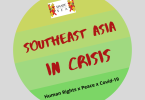Reni JuwitasariResearch Associate, Asian Research Center for International Development (ARCID),School of Social Innovation, Mae Fah Luang University
 Article 27 of the Convention on the Rights of the Child (CRC) emphasizes that State-Parties shall take appropriate measures to assist parents and others responsible for the child in implementing the rights by providing material and programs regarding nutrition. As a state party to CRC, Indonesia has also included this Article in its national development plan. However, during this outbreak, the right of children, especially those living in rural areas of Indonesia, to nutrition is not well protected.As all of us know by now, COVID-19 can easily be transmitted to anyone, regardless of age, gender, race, and socio-economic status. However, its impacts are very much felt by vulnerable groups such as the elderly, women, migrant workers, and children (Qiu, et al., 2020). They have been gravely affected physically, psychologically, and emotionally by the ubiquitous lockdowns.Malnutrition is a reality faced by millions of children in developing countries even before the pandemic. In Indonesia, children are able to access nutritious food via two channels. These channels are the nutritional programs from the community-based preventative and promotive care (POSYANDU or Integrated Service Stations) and school lunch project named Program Gizi Anak Sekolah (PROGAS or Nutrition Program for School Children). These programs help to alleviate widespread malnutrition amongst children living in depressed and rural areas. Unfortunately due to the COVID-19 response, those programs are forced to stop. The absence of these programs had led to hunger to vulnerable children and left them malnourished with the possible effect on their overall health as well as brain development. As a result, the number of malnourished children and malnutrition levels in general in Indonesia are predicted to increase during the COVID-19 Pandemic (Republika, 2020). Furthermore, low-income families that rely on informal livelihood cannot afford the basic nutritious food due to diminishing income during the COVID-19 Pandemic. Some charity-based assistance from communities and the government generally provide community-supported food packages stuffed with products like instant noodles, canned-fish, canned-milk, or condensed milk. However, these processed food are naturally unfit for children. Therefore, the government had appealed to parents to be creative in utilizing locally available food ”but to no avail due to the lack of resources.Palpably, COVID-19 is affecting children far beyond those it directly infects. The pandemic has disrupted families and institutions, increasing risks for children to exposure of malnutrition. While Indonesia has made significant progress in implementing CRC Article 27, it has failed in ensuring access to nutrition during the Covid-19 pandemic. Therefore, it is required to provide coordinated leadership among central and peripheral governments concerning on nutrition information, surveillance and monitoring on children activity to ensure children getting nutritious food as not all parents understand on the issue of malnutrition. Otherwise, without clear guidance and surveillance on the nutrition information, Indoesia will not only be experiencing a waves of infections, but also an sharp increase in sick and malnourished children.References:Qiu, J. et. al. (2020). A Nationwide Survey of Psychological Distress among Chinese People in the COVID-19 Epidemic: Implications and Policy Recommendations. General Psychiatry, 33(2):e100213. Retrieved from: https://www.ncbi.nlm.nih.gov/pmc/articles/PMC7061893/Republika. (2020). The Number of Stunting in Indonesia has been Predicted an Increase due to Pandemic. Retrieved from: https://republika.co.id/berita/qadjjl384/angka-emstuntingem-di-indonesia-diperkirakan-naik-akibat-pandemi.
Article 27 of the Convention on the Rights of the Child (CRC) emphasizes that State-Parties shall take appropriate measures to assist parents and others responsible for the child in implementing the rights by providing material and programs regarding nutrition. As a state party to CRC, Indonesia has also included this Article in its national development plan. However, during this outbreak, the right of children, especially those living in rural areas of Indonesia, to nutrition is not well protected.As all of us know by now, COVID-19 can easily be transmitted to anyone, regardless of age, gender, race, and socio-economic status. However, its impacts are very much felt by vulnerable groups such as the elderly, women, migrant workers, and children (Qiu, et al., 2020). They have been gravely affected physically, psychologically, and emotionally by the ubiquitous lockdowns.Malnutrition is a reality faced by millions of children in developing countries even before the pandemic. In Indonesia, children are able to access nutritious food via two channels. These channels are the nutritional programs from the community-based preventative and promotive care (POSYANDU or Integrated Service Stations) and school lunch project named Program Gizi Anak Sekolah (PROGAS or Nutrition Program for School Children). These programs help to alleviate widespread malnutrition amongst children living in depressed and rural areas. Unfortunately due to the COVID-19 response, those programs are forced to stop. The absence of these programs had led to hunger to vulnerable children and left them malnourished with the possible effect on their overall health as well as brain development. As a result, the number of malnourished children and malnutrition levels in general in Indonesia are predicted to increase during the COVID-19 Pandemic (Republika, 2020). Furthermore, low-income families that rely on informal livelihood cannot afford the basic nutritious food due to diminishing income during the COVID-19 Pandemic. Some charity-based assistance from communities and the government generally provide community-supported food packages stuffed with products like instant noodles, canned-fish, canned-milk, or condensed milk. However, these processed food are naturally unfit for children. Therefore, the government had appealed to parents to be creative in utilizing locally available food ”but to no avail due to the lack of resources.Palpably, COVID-19 is affecting children far beyond those it directly infects. The pandemic has disrupted families and institutions, increasing risks for children to exposure of malnutrition. While Indonesia has made significant progress in implementing CRC Article 27, it has failed in ensuring access to nutrition during the Covid-19 pandemic. Therefore, it is required to provide coordinated leadership among central and peripheral governments concerning on nutrition information, surveillance and monitoring on children activity to ensure children getting nutritious food as not all parents understand on the issue of malnutrition. Otherwise, without clear guidance and surveillance on the nutrition information, Indoesia will not only be experiencing a waves of infections, but also an sharp increase in sick and malnourished children.References:Qiu, J. et. al. (2020). A Nationwide Survey of Psychological Distress among Chinese People in the COVID-19 Epidemic: Implications and Policy Recommendations. General Psychiatry, 33(2):e100213. Retrieved from: https://www.ncbi.nlm.nih.gov/pmc/articles/PMC7061893/Republika. (2020). The Number of Stunting in Indonesia has been Predicted an Increase due to Pandemic. Retrieved from: https://republika.co.id/berita/qadjjl384/angka-emstuntingem-di-indonesia-diperkirakan-naik-akibat-pandemi.





